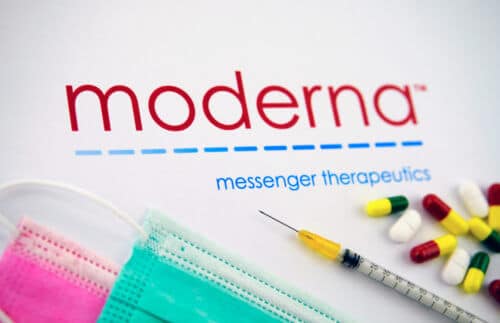Prof. Johnny Gershoni from Tel Aviv University, who was recently announced to have filed a patent for a corona vaccine, explains in an interview to the scientific website how the vaccine works as offered by the Moderna company, and where the protein synthesized as part of the fight against SARS and MERS viruses can increase the effectiveness of the new vaccine

The American technology company Moderna, operating from Cambridge, Massachusetts, announced on Tuesday progress in the development of a vaccine for COVID 19 patients based on messenger RNA ((mRNA). The company announced that one of the candidates for a vaccine against the SARS-CoV-2 virus, called mRNA-1273, has successfully passed The first phase of the clinical trial (Phase 1, conducted under the leadership of the (American) National Institute of Allergy and Infectious Diseases (NIAID), part of the National Institutes of Health (NIH).
In the first phase of the experiment, 45 experimenters participated so far, who received the vaccine in different doses. Initially, the participants were divided into 3 groups of equal size, and each group received a different dose of vaccine: 25 micrograms, 100 micrograms and 250 micrograms. So far, positive results have come from the first two groups that received 25 and 100 micrograms. Regarding the third group, the samples have not yet been tested.
The participants in these groups received two doses, with the second dose being given 29 days after the first. On the 43rd day of the experiment, two weeks after the administration of the second dose, antibodies were detected in at least 8 participants. Among the members of the group that received 25 micrograms, antibodies were detected at the same level as patients who recovered from Corona, and among the 100 microgram group, antibodies were detected at a higher level than those who recovered.
Currently, neutralizing antibody data are only available for the first four participants in each of the 25 mcg and 100 mcg dose level vaccines. According to the binding antibody data, the mRNA-1273 vaccine induced neutralizing antibodies in all eight of these participants, as measured in an experiment in which the activity of the antibodies was tested against a live virus, of course in cell culture.
Prof. Johnny Gershoni from the School of Molecular Cell Biology and Biotechnology in the Faculty of Life Sciences of Tel Aviv University became famous about a month ago when he received approval from the US Patent Authority for a patent for an innovative vaccine for viruses from the Corona family. The vaccine is based on hitting the 'Achilles heel' of the virus: a region of the virus's coat protein called RBM, through which the virus binds to the receptor in the human cell in order to penetrate it. The patent was approved in March 2020. "The patent has been in the process of approval for five years and by chance it was received in the midst of the current corona epidemic" explains Prof. Gershoni.
We asked Prof. Gershoni to explain what is special about Moderna's announcement, and whether or how the development of the laboratory under his leadership could help vaccine developers, including the new RNA-based vaccine.
"In the development of vaccines, they are looking for a way to create one of the proteins of the virus, usually those that make up the envelope and especially those that bind to the attacked cell. This is true for the flu, hepatitis B or papilloma, the virus that causes cervical cancer. In all cases, we try to stimulate an immune response against the virus's coat protein. The insight is that the antibodies that are formed bind to the envelope protein and thus prevent the virus from domesticating and binding to the target cell and as a result, they neutralize the virus and reduce its ability to infect our tissue cells."
Contrary to the criticisms that are made about China, in regards to the virus research, the Chinese acted quickly. "On January 9, less than a month after the appearance of the first corona patients, they published its genetic structure. As a result, it was possible to identify that it was a virus from the corona family - a family of RNA viruses and not DNA. The new virus SARS CoV2 is a corona virus, these are the largest among the known RNA viruses.
In 2002, the SARS epidemic broke out, during which approximately 8,000 people around the world were infected with the SARS virus for nine months until it disappeared. The mortality rate from the Sars disease reached 10%, meaning about 800 dead. In 2012, another corona-type disease arose, which started in Saudi Arabia and was called MERS, which infected about 4,000 people worldwide. MERS was more lethal than SARS, - about a third of those infected with it died. "Today when we see these numbers, they seem relatively small to us - isn't it just today that more than 10,000 people were infected in the US alone! ". The current virus is much less deadly than its predecessors, but also much more contagious.
"Following the two previous corona epidemics, quite a few studies were done about the envelope protein of these viruses and in particular the areas that connect to the target cells.

"The corona protein is a relatively large protein and contains about 1,200 amino acids. Inside it is a section known as S1 containing about 660 amino acids and within this structure there is a smaller section (about 200 amino acids) that binds the receptor and thus the virus connects to the target cells. Over the years since the SARS and MERS epidemics, the knowledge of the scientific community has increased, so when the Chinese published the structure of the genome, as mentioned in January, many groups began to try to use this knowledge to develop vaccines. These groups include Moderna's researchers as well as researchers from other universities - for example Oxford, competing companies such as Johnson & Johnson and Sanofi, the US Army and the National Institutes of Health (NIH). (Editor's note - Israeli researchers also got involved, as we learned about a group from Migl in Kiryat Shmona, but it is also known that the IDF and the biological institute are in the global race to obtain vaccines and medicines).
"Many researchers seek to domesticate those envelope proteins, the "spikes" called SPIKE, and most of the efforts went into expressing this protein or parts of it as a template for the vaccine. The assumption is that if the envelope protein is injected into healthy people, this will 'prime' the immune system of the vaccinated person, which will result in the production of antibodies against the virus protein. These antibodies will recognize the real virus in the event that we become infected in the future and will help to neutralize it before we get sick."
The Moderna company did the same, but unlike other groups, they proposed not injecting the protein itself, but messenger RNA - a nucleic acid that contains the genetic template that matches the structure of the protein and is used to produce the coat protein by the cell itself.
"The idea of Moderna is a new idea and does not yet exist in any approved vaccine so far, but it is an original and beautiful idea. It may also have an advantage because it is easier to synthesize the RNA than to produce the viral protein itself. They did a first clinical trial on a small group of volunteers in Seattle, and tested whether the RNA was taken up by the cells of the vaccinated and whether it stimulated the production of antibodies. They then showed that the antibodies were able to block cell infection by the virus. They reported that the new vaccine produces antibodies at a level similar to or higher than that of patients who have recovered from the new disease. This is definitely a nice development. I guess we are expected to hear similar reports from the other groups involved in the development of vaccines for Corona.
Where does your development fit in?
"The results of the Moderna company are beautiful and encouraging. However, like other companies, most of the vaccines under development rely on the envelope protein that can stimulate the creation of many and varied antibodies. Only a small part of them are targeted at the receptor binding site. This site is the "soft underbelly" of the virus, and antibodies that miss the target are not helpful in the fight against the virus. Our vaccine is unique in that it contains the isolated binding site, purified and free of irrelevant regions. Therefore, I believe that the vaccine we are trying to develop will be able to complement the other vaccines."
"I estimate that no matter which group develops the first vaccine, one injection will not be enough, but they will have to give boost injections to increase the immune response. It may be beneficial to vaccinate with a booster shot that will be based on our vaccine, to sharpen and increase the immune response exactly for the desired purpose. Moderna's vaccine is important and it is possible that a boost injection with our vaccine will even improve its effectiveness."
More of the topic in Hayadan:

5 תגובות
mRNA does not enter the cells, so compounds are added to it that help it penetrate.
Read more on the website of the Davidson Institute, but remember that for the purpose of understanding you need a background in biochemistry, genetics, biology. The explanations are not suitable for the ultra-Orthodox and the creators of all kinds of 'conspiracy theories'...
RNA damages our genes and the original DNA structure and more. The problems of God have mercy...search the internet and you will find it
Won't the injection of RNA and the means of introducing it into the cells... cause a dangerous mutagenic process? And maybe cancer too.
I wonder how the Chinese knew the genetic sequence of the virus before everyone else on January 9? Today there are 7 viruses, and if I understood correctly about one or more, a genetic sequence of an unpublished length corresponding to the AIDS virus also appears. Is the above vaccine supposed to vaccinate all types of viruses?
I lack an explanation of how mRNA passes into the cell in its entirety and how the protein synthesized in the cell is exposed to the immune system.
It sounds like this method opens the possibility to vaccinate against any cobbled protein very quickly - hope for a more serious epidemic